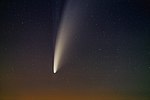2020 CW
2020 CW is an asteroid classified as a Near-Earth Object (NEO) that passed within 9,730 miles (15,660 km) of the Earth on February 1, 2020, with a fly-by speed of 13.2 miles (21.2 km) per second.[3] The household-appliance-sized asteroid passed within the orbit of satellites in the geostationary ring at 22,300 miles (35,900 km) above Earth's equator.[1] At the time, it was the closest approach in the year 2020. Since then, 2020 JJ made a closer approach on May 4, 2020.[5]
| Discovery [1] [2] [3] | |
|---|---|
| Discovery site | Mount Lemmon Survey |
| Discovery date | February 1, 2020 |
| Designations | |
| 2020 CW | |
| Apollo (NEO)[2][4] | |
| Orbital characteristics[2] | |
| Epoch 59000.0 MJD | |
| Aphelion | 1.743 AU |
| Perihelion | 0.424 AU |
| Eccentricity | 0.609 |
| 412.1 days | |
| Inclination | 5.9° |
| Physical characteristics | |
Mean diameter | 3.5 feet (1.1 m)[2] |
| 32.6[2] | |
The asteroid was discovered February 1, 2020 using the Mount Lemmon Survey telescope in the Santa Catalina Mountains northeast of Tucson, Arizona.[2] The next encounter closer than the Moon is predicted to occur February 5, 2029 at a distance of 11,830 miles (19,040 km) or more.[3]
References
- Mack, Eric (February 4, 2020). "Adorable asteroid 2020 CW makes one of the closest passes by Earth ever seen". CNET.
It was a harmless flyby for the record books.
- "ESA space situational awareness 2020CW". European Space Agency. Retrieved July 29, 2020.
- "JPL Small-Body Database Browser (2020 CW)". Jet Propulsion Laboratory. Retrieved July 29, 2020.
- "IAU Minor Planet Center 2020 CW". International Astronomical Union. Retrieved July 29, 2020.
- "NEO Earth Close Approaches". Center for Near Earth Object Studies (CNEOS). Retrieved July 29, 2020.
Table Settings: All available data, Nominal dist. <= 1LD, no H limit, sort by CA Distance Nominal


